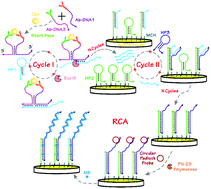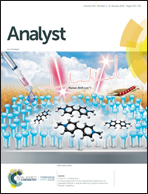An ultrasensitive electrochemical immunoassay based on a proximity hybridization-triggered three-layer cascade signal amplification strategy†
Abstract
In this paper, an ultrasensitive electrochemical immunoassay was constructed for the determination of carcinoembryonic antigen (CEA) based on a proximity hybridization-triggered three-layer cascade signal amplification strategy. In the presence of CEA and two antibody-labeled DNA strands (Ab-DNA1 and Ab-DNA2), a sandwich proximate complex was formed which could hybridize with the hairpin DNA (HP1) and open it, initiating the degradation process of exonuclease III (Exo III) accompanied by the release of a sandwich proximate complex used for Cycle I and autogenous yield of a DNA fragment. The fragment was then employed as a ST-DNA (secondary target DNA fragment) for the subsequent binding to the other hairpin DNA (HP2) on the gold (Au) electrode surface to trigger the catalytic hairpin assembly (CHA, Cycle II) and rolling circle amplification (RCA). After the immersion of the above final electrode into methylene blue (MB) solution, an amplified signal was obtained. The proposed electrochemical immunoassay had a good linear relationship in the CEA concentration from 10 fg mL−1 to 100 ng mL−1, and the limit of detection (LOD) was found to be 4.2 fg mL−1. Moreover, with the excellent sensitivity and selectivity based on a three-layer cascade signal amplification strategy, the developed electrochemical immunoassay can pave the way for analysis of other biomarkers.



 Please wait while we load your content...
Please wait while we load your content...